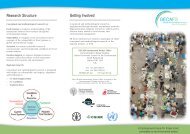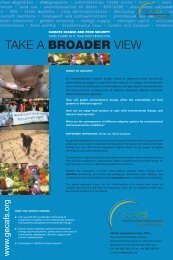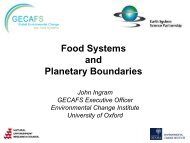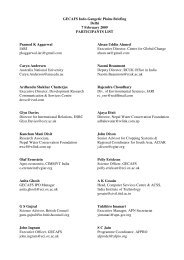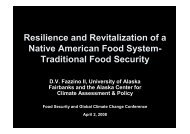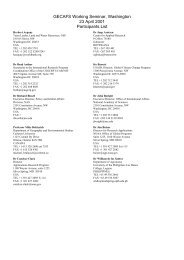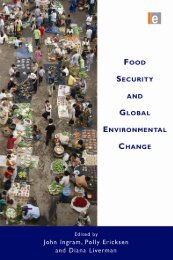governance focuses on the range of scales and levels inherent in food systems and notes boththe importance of, and problems arising from, the cross-scale and cross-level interactions.Another classification of multilevel governance approaches differentiates between Type 1(general-purpose jurisdictions; non-intersecting memberships; jurisdictions at a limitednumber of levels; and a system-wide architecture at a limited number of levels) and Type 2(task-specific jurisdictions; intersecting memberships; no limit <strong>to</strong> the numbers ofjurisdictional levels; and flexible design) (H. Schroeder, pers comm). Type 1 emphasizes themultiple tiers at which governance takes place, and is focused mainly on the administrativeunits of municipality, province and national government. This is akin <strong>to</strong> the ‘monocentric’system described above. Type 2 includes networks and partnerships between public andprivate ac<strong>to</strong>rs across levels of social organization and is more akin <strong>to</strong> the ‘adaptivegovernance’ described above. It includes both formal and informal rights, rules and decisionmakingprocesses.But however ‘appropriate’ ‘adaptive governance’ or ‘Type 2 governance’ may seem, theystill have <strong>to</strong> operate within and/or alongside the formal monocentric / Type 1 governancesystems that typify many contemporary societies. How can these two systems co-exist <strong>to</strong>maximum advantage? Boundary organisations (Holmes et al., 2010) and boundary agents(i.e. individuals) are needed who can span the two governance systems.This problem of the additional complexity of different governance systems can often be seenwhen there is a food ‘scare’, and especially when compounded by cross-scale and cross-levelchallenges. These usually arise suddenly and attract high media interest demanding a rapid‘policy’ response from the establishment (see Box 1, below).Prompted by the increasing dominance of the major food retailers in the food system (asnoted above), further governance questions relate <strong>to</strong> the location and concentration of powerand role of marketing in changing consumer behaviour regarding diet and waste. The need <strong>to</strong>modify diets for health reasons and reduce waste for environmental, financial and ethicalreasons has a strong governance aspect: who is responsible for bringing about change andwhat governance approach will be most effective?Finally, food system governance is increasingly important in relation <strong>to</strong> the growingenvironmental agenda. Liverman et al. (2009) identify three governance questions whicharise when analysing food systems. The first includes the extent <strong>to</strong> which concerns aboutfood systems are incorporated in<strong>to</strong> global and regional environmental governance. As the fullset of food system activities and food security outcomes are poorly represented inenvironmental assessments (Wood et al., 2010), they are not highlighted in the discussionsaround either adaptation or mitigation agendas in the UNFCCC process or in environmentalcomponents of regional trade agreements. The second concerns the ways in which thegovernance of the food system affects the earth system, for instance how the shifts <strong>to</strong> longglobal supply chains controlled by large private firms affect climate and land use. The third120
considers the inadvertent impacts of governance on food systems, for instance the interactionbetween biofuels, energy efficiency or carbon sequestration projects and food security.Enhanced research on food system governance clearly has many interesting and highly usefulavenues <strong>to</strong> explore and would be a major contribution <strong>to</strong> alleviating food insecurity.Box 1 The E. coli outbreak in Germany, June 2011: an example of multi-level food systemgovernance failure regarding food safety.The response <strong>to</strong> E. coli outbreak in Germany in June 2011 is a good example of the complexitymulti-scale, multi-level interactions bring <strong>to</strong> food safety aspects of food system governance. Ithighlights – in this case – monocentric governance failings. The contamination was initiallythought <strong>to</strong> have come from the import of Spanish produce in<strong>to</strong> Germany (later proved wrong) andthereby spanned spatial and jurisdictional levels. At European level, the aim is <strong>to</strong> promote tradebetween member states, but also <strong>to</strong> have public food safety systems for the region in place.National food safety and health agencies are only mandated <strong>to</strong> operate within the nationalboundaries, i.e. on a different jurisdictional level. With the health problem being largely confined<strong>to</strong> the Hamburg region, the local health management had <strong>to</strong> address the immediate health problem.All these levels have a monocentric system in place, operating at the respective level. Given thesethree distinct spatial and jurisdictional levels, it is hard <strong>to</strong> establish who is in charge of managingthe situation, and what the formal lines of communication are. The monocentric approach did notappear able <strong>to</strong> deal with the multi-level emergency.As reported in a Leading Article in The Independent (11 June 2011) the E. coli outbreak exposedflaws in food system governance in Germany and in Europe: “Germany’s federal structure, inwhich most responsibility for health is devolved <strong>to</strong> individual states, may be a fac<strong>to</strong>r in the ill-coordinatedresponse. … Nor was the EU well equipped <strong>to</strong> compensate for failings at Germannational level. EU officials could do little more than watch as the Germans and Spanish tradedinsults, even though the E. coli outbreak was claiming victims across Europe and growers not onlyin Spain faced ruin”. The cross-level interactions within the food system, spanning multiple foodsystem activities affecting food system outcomes related <strong>to</strong> food safety, food production andlivelihoods could perhaps have been better managed had an adaptive governance system been inplace, or rapidly arisen. Health researchers could have communicated informally with each otherand with growers, possibly ascertaining the source of contamination more quickly. This “adaptivegovernance” approach proved successful in the case of the SARS outbreak in SE Asia in 2006,where an informal network of scientists provided a faster ‘solution’ than the formal monocentricsystems at the international and national levels (C. Termeer, pers comm).Practical challenges <strong>to</strong> implementing food security researchThe sub-sections above identify many conceptual scientific challenges <strong>to</strong> improving foodsecurity. Methodological challenges also arise, and although several are discussed in Paper 6,a few are worth stressing here, in the context of the scientific advances and challengesidentified above:121
- Page 1 and 2:
From Food Production to Food Securi
- Page 3 and 4:
From Food Production to Food Securi
- Page 5 and 6:
Table of ContentsAbstract .........
- Page 7 and 8:
Paper 6: Undertaking Research at th
- Page 9:
AbstractFood security is a conditio
- Page 12 and 13:
2010 about 925 million people had t
- Page 14 and 15:
water) are used, and reduce negativ
- Page 16 and 17:
While the flow of the argument abou
- Page 18 and 19:
determine interactions along and be
- Page 20 and 21:
Paper 3: A Food Systems Approach to
- Page 23:
From Food Production to Food Securi
- Page 26 and 27:
concerns and are now issues that mu
- Page 28 and 29:
the relationships between GEC and f
- Page 30 and 31:
Theme 2 aims to understand how comm
- Page 32 and 33:
GEC and the Food System of the Indo
- Page 34 and 35:
Paper 2: The role of agronomic rese
- Page 36 and 37:
These advances have resulted from a
- Page 38 and 39:
Crop selection to determine mechani
- Page 40 and 41:
Agronomic science is central to imp
- Page 42 and 43:
Agronomic research in relation to f
- Page 44 and 45:
The discussion above identifies a n
- Page 46 and 47:
interventions and political inertia
- Page 48 and 49:
While research on producing food ha
- Page 50 and 51:
Box 1 Food system Activities and fo
- Page 52 and 53:
In addition to broadening the debat
- Page 54 and 55:
options. Examples already seen rang
- Page 56 and 57:
Figure 3 Outcomes for 10 variables
- Page 58 and 59:
Figure 4 Nine ‘planetary boundari
- Page 60 and 61:
Figure 5 Environmental change, food
- Page 62 and 63:
Table 1: Indicative analysis of the
- Page 65:
From Food Production to Food Securi
- Page 68 and 69:
Trade Agreement (NAFTA) and the Eur
- Page 70 and 71:
Parry et al., 2005). Conducting foo
- Page 72 and 73:
is provided in the ESF/COST Forward
- Page 74 and 75:
Paper 5: Engaging Stakeholders at t
- Page 76 and 77:
into actions (strategies, policies,
- Page 78 and 79:
Box 2 Engaging with stakeholders in
- Page 80 and 81: Box 3 Setting the research agenda f
- Page 82 and 83: Third, and of considerable practica
- Page 84 and 85: Figure 2: Organizing and understand
- Page 86 and 87: organizations made up of numerous n
- Page 88 and 89: Elements of good practice in stakeh
- Page 90 and 91: Finally, it is worth noting that fo
- Page 92 and 93: development (Lee, 1999; Gunderson a
- Page 94 and 95: Box 7 The GECAFS stakeholder survey
- Page 96 and 97: ‘break down’ what might be a hi
- Page 98 and 99: Paper 6: Undertaking Research at th
- Page 100 and 101: agriculture in many parts of the wo
- Page 102 and 103: gaps. The presence of a strong tech
- Page 104 and 105: an average of two years to coalesce
- Page 106 and 107: Institute for Meteorology and Hydro
- Page 108 and 109: Identifying case study sitesResearc
- Page 110 and 111: can both benefit from and contribut
- Page 112 and 113: Box 5 Mapping stakeholder interests
- Page 114 and 115: Holding planning meetings in locati
- Page 116 and 117: This reorientation of the debate fr
- Page 118 and 119: Importance of this type of research
- Page 120 and 121: Integrating the food system concept
- Page 122 and 123: awareness of the GEC issues within
- Page 124 and 125: pollutants were then introduced as
- Page 126 and 127: communities operating in food syste
- Page 128 and 129: Improving input-use efficiency acro
- Page 132 and 133: Developing research agendas in supp
- Page 134 and 135: The renewed approach to interdiscip
- Page 136 and 137: BIELAK, A., HOLMES, J., SAVGÅRD, J
- Page 138 and 139: EAKIN, H. 2010. What is Vulnerable?
- Page 140 and 141: GODFRAY, H. C. J., BEDDINGTON, J. R
- Page 142 and 143: INGRAM, J. S. I. & FERNANDES, E. C.
- Page 144 and 145: LYUTSE, S. 2010. The One Billion To
- Page 146 and 147: RAYNER, S. & MALONE, E. L. 1998. Hu
- Page 148 and 149: UNDP 2006. The 2006 Human Developme
- Page 150 and 151: activities “from plough to plate
- Page 152 and 153: contribution to the science agenda:
- Page 154 and 155: urgently needed, and - given the gr
- Page 156 and 157: GECAFS plannenmakerij stelde vast d
- Page 158 and 159: ieder hun eigen groep van betrokken
- Page 160 and 161: het gebied van beheer hebben betrek
- Page 162: Curriculum VitaeFollowing a BSc in



